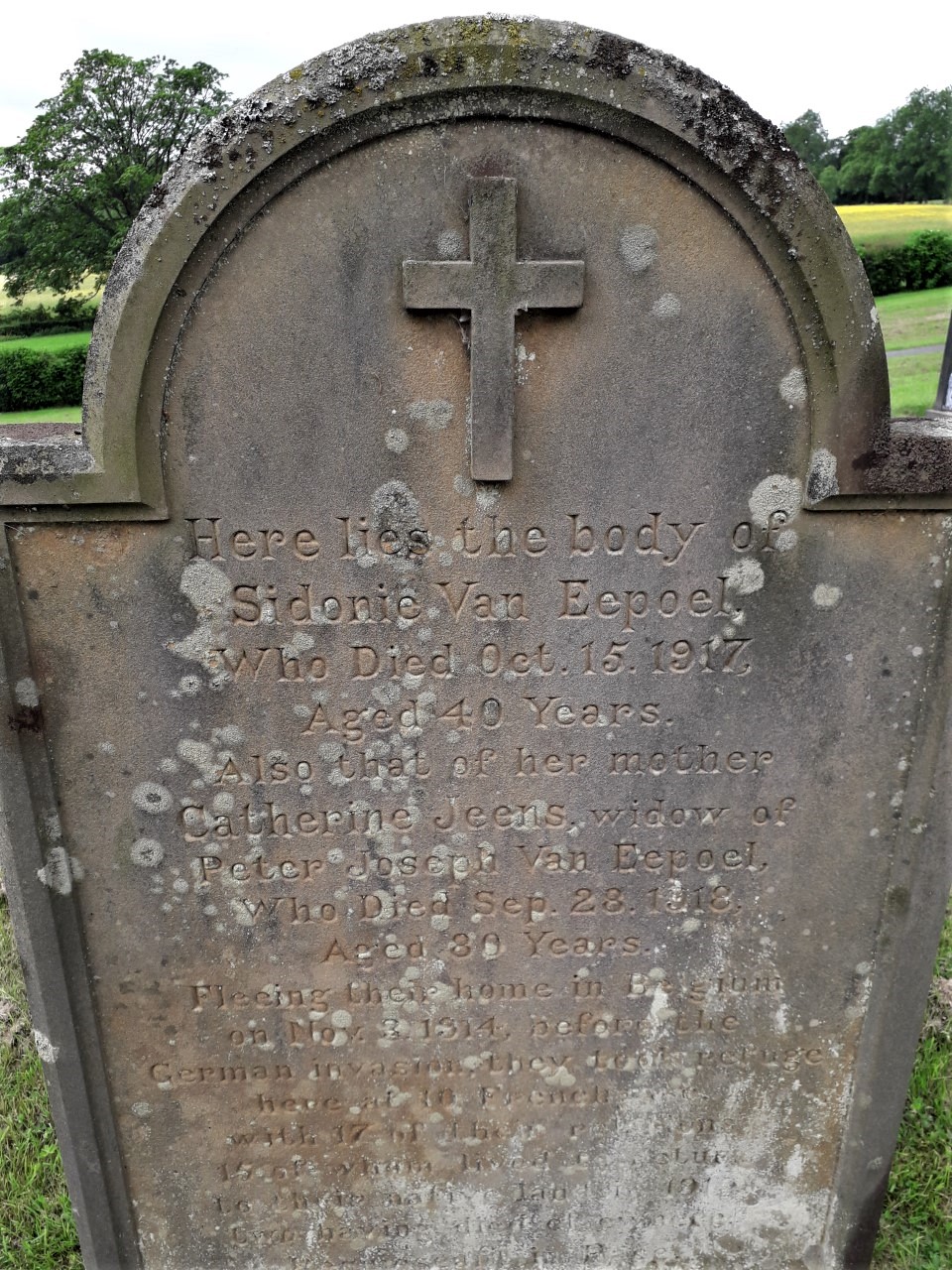
Sidonie van Eepoel died just a few months before the end of the First World War at the age of 40. Her family story is shared with a quarter of a million other Belgians, who fled to England to escape the invading German Army in 1914. Around 10,500 of these refugees ended up in Yorkshire, the biggest intake of any area outside London. For those who stepped off the train after up to a month of travelling there was both relief and exhaustion. It was after mid-September 1914 that were the first Belgian migrants started to arrive in Yorkshire. Sidonie’s family arrived in Richmond in November 1914, establishing their home at 10 Frenchgate. A total of 17 Belgians appear to have been made welcome in Richmond, with some also living at 10 Park Wynd.
While Sidonie and her mother died during the war and were buried in Richmond in the town cemetery on Reeth Road, 15 of their friends and family returned to their native land when hostilities ceased. They were fit, safe and well thanks to the generosity and hospitality of the people of Richmond in their time of need. Photo submitted by Sara Cox.

An extract from L’Echo de Belgique, which reveals the family were from Heyst-op-den-Berg near Antwerp.
Explore more memories from the ribbon
-
Erasmus Darwin
Erasmus Darwin was born on the 7th December 1881 in Cambridge and lived at ‘The Orchard’. He was the only son of Horace Darwin FRS (Fellow of the Royal Society) who was Chairman of the Cambridge Scientific Society. He was also the grandson of the famous naturalist Charles Darwin. Erasmus was educated at Horris Hill School near Newbury and at Marlborough. He then went on to Trinity College, Cambridge University to study Mathematics. On leaving Cambridge he worked at Mather and Platts in Manchester, a hydraulics and pump engineering company. He then moved on to work for Bolckow, Vaughn & Co Ltd Iron and Steel in Middlesbrough, whereby, at the outbreak of the war he was Secretary of the Company. He lived at the time at Saltburn on the north east Yorkshire coast. As soon as war broke out he joined up and was gazetted on the 12th September 1914 as a 2nd Lieutenant the 4th Battalion Yorkshire Regiment. Apparently just before he left England he was summoned to the War Office and offered a Staff appointment at home in connection to munitions work. Though the work was important he opted to stay with his unit making the case that there were plenty of older men equally qualified for the work. The 4th Battalion arrived in France on the 18th April 1915 and were straight away into the 2nd Ypres offensive which started on the 22nd April. The Battalion was involved in the Battle of St Julien in the heart…
-
Ernest Wyatt Burnett
Gerald Burnett visited the museum to relate the story of his grandfather Ernest Wyatt Burnett. My Grandfather, Ernest Wyatt Burnett was born in Chudleigh, Devonshire, in 1886. After minimal schooling and several agricultural jobs, Ernest moved to London and became a chauffeur with various employers including Thomas Tilling. He spent the pre-war years driving around Great Britain with American tourists and contemporary industrialists such as Tommy Lipton of tea fame. Ernest enlisted with the Royal Army Service Corps, Mechanical Transport Branch, in April 1915 and became a Staff Car driver. In 1915, the Government appointed five official Western Front War Correspondents, Philip Gibbs, Percival Phillips, H. Perry Robinson, W. Beach Thomas and Herbert Russell. Ernest was assigned to be their driver, a position he held until the end of the war. Ernest was transferred to the Reserve in February 1919. Alongside his ‘Pip, Squeak and Wilfred’ decorations he was awarded a Silver Medal for Merit by Nicholas I, King of Montenegro. During WW2, Ernest served with the Home Guard at Balcombe Place, his Sussex home, where he was chauffeur to Lady Gertrude Denman who was President of the Women’s Institute and Honorary Director of The Women’s Land Army. My Grandfather was one of the lucky ones. He served his country, survived two World Wars, and lived a full and interesting life.
-
Oakley Alsop Browning
Researched by Will Young. Second Lieutenant Oakley Alsop Browning is burried in the cemetery in Catterick Village. He enlisted on 6th October 1915 as 9587 Private Browning, as a member of 12th Field Ambulance, Australian Imperial Force (Browning came from North Carlton, Victoria, Australia and was the son of Major Demby de Courcey Browning, Commanding Officer of Base Command, Keswick Barracks, Adelaide). He was commissioned as a Second Lieutenant into the Royal Flying Corps on 17th March 1917. On 11th August 1917, while flying an Avro 504 at Catterick aerodrome he was in a collision with a BE12 flown by Lieutenant Errington Edward Castle. Browning died on the same day while Castle (who is also burried in Catterick) died of his injuries on 12th August.
